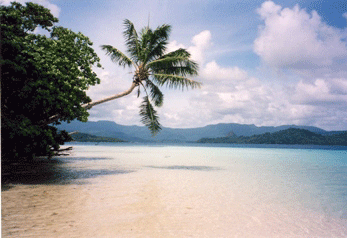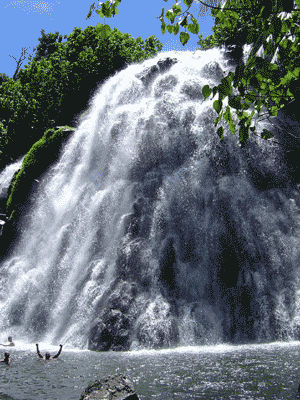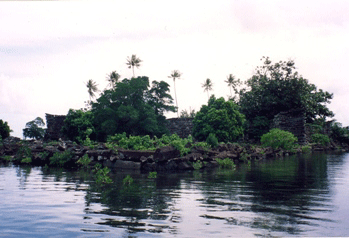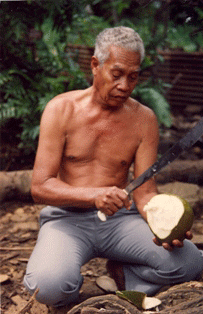Overview
![Sleeping Lady Island, Kosrae. [courtesy FSMVB]](https://webarchive.library.unt.edu/eot2008/20080916131818im_/http://www.doi.gov/oia/images/Sleeping-Lady-Island---Kosrae.gif) |
| Sleeping Lady Island, Kosrae. [Courtesy of FSMVB] |
The strategic and economic relationship between the FSM and the United States goes back to the end of World War II. Soon after the end of the War, the FSM became a part of the United Nations Trust Territory of the Pacific Islands, which the United States administered until its dissolution in the late 1970s. The FSM became a sovereign nation in 1986 and entered into a special strategic and economic agreement, the Compact of Free Association, with the United States. Under the Compact, the United States retains exclusive access to the FSM’s territorial waters for civilian and military objectives in return for economic and financial aid. The United States is also responsible for the defense of the FSM. The first financial package of the Compact covered 1986-2001 and, as required by the treaty, the two sides negotiated a new financial package in 2003 that covers 2004-2024. At the end of this period, Compact grants will end and a trust fund, set up as a part of the second financial package, will generate a certain stream of income that will replace Compact grants. Apart from financial aid from the United States, an important provision of the Compact, is the right of FSM citizens to enter the United States and its territories as nonimmigrants without need for visas to live, study and work for duration of status.
The FSM economy recovered from a steep decline in the late 1990s to a somewhat steady course during 2000-2003. Since 2003, it has stagnated. In 1995-2006, FSM’s real GDP increased a scant 0.1 percent a year. The State of Yap was the only economy of the four states that grew. However, the growth rate was less than one percent a year in 1995-2006. During the same period, Chuuk’s economy grew 0.2 percent a year, followed by 0.1 percent decline annually for both Pohnpei and Kosrae. Total real GDP (expressed in 1998 dollars) was an estimated $211.8 million in 2006, less than what it was the year before or a decade earlier.
Average Real GDP Growth Rates per Year by States and Economic Sector, 1995-2006
| |
GDP |
Government |
Private Sector |
| Chuuk |
0.2 |
-1.6 |
0.7 |
| Kosrae |
-0.1 |
0.0 |
-1.2 |
| Pohnpei * |
-0.1 |
-0.7 |
-1.0 |
| Yap |
0.9 |
-0.5 |
1.2 |
| FSM |
0.1 |
-0.9 |
-0.3 |
* includes the national government
Yap was the only state which had a higher real per capita GDP in 2006 than in 1995. Each of the other three states had a lower per capita GDP in 2006 than in 1995. Among the states losing ground in terms of real per capita GDP, Kosrae exhibited the greatest potential for future problems, in part, because it relies more heavily on government than other states. Its real per capita GDP dropped every year in 2003-2006.
![Children in Chuuk. [courtesy FSMVB]](https://webarchive.library.unt.edu/eot2008/20080916131818im_/http://www.doi.gov/oia/images/Children-in-Chuuk.gif) |
| Children in Chuuk.
[Courtesy of FSMVB] |
Reflecting the evidence of a static economy, total employment in the FSM in 1995-2006 remained stable, ranging from a high of 17,502 in 1995, the peak of the business cycle during the first financial package, and 16,162 in 1999. After 1999, employment recovered somewhat, but did not match the previous peak level. It averaged 16,585 during the 1995-2006 period. While detailed breakdown of employment types is useful for insight into the FSM’s labor market, the two broader categories, private sector and public sector, have changed little over the years.
A critical and potentially destabilizing factor in the FSM is the low ratio of formal employment to population. In 2006, 15.2 percent of the population of 108,549 was formally employed. In 1995, a peak in the business cycle, this ratio was 16.5 percent, the highest. During the 1995-2006 period, employment as a percent of total population averaged 15.5 percent.
By contrast, employment as a share of total population in the United States, for instance, was 47.3 percent in 2003 and averaged 47.2 percent over the 1990-2003 period. The low ratio of employment to population suggests that increases in the standards of living will be harder to achieve because of a small percentage of the population has to support the rest of the population. Given these facts, more Micronesians, not fewer, would resort to emigration. With subsistence economy still being an important part of the whole, about 15 percent of GDP, it generates both goods for domestic consumption and some work.
More detailed information on the economy is available in the Annual Compact Reports.
The FSM extends 1,800 miles across and features the archipelago of the Caroline Islands. Palikir (located on Pohnpei), the FSM capital, is 2,900 miles southwest of Honolulu and 1,000 miles southeast of Guam. The four states and capitals in the FSM are Kolonia, Pohnpei; Moen, Chuuk; Colonia, Yap; and Tofol, Kosrae.
| Click on the image below to access the full version of the map. |
 |
| Courtesy of UofTexas. |
 |
| Pohnpei is the largest and tallest island in the FSM. |
In 1525, Portuguese navigators in search of the Spice Islands (Indonesia) came upon Yap and Ulithi. Spanish expeditions later made the first European contact with the rest of the Caroline Islands.
Spain claimed sovereignty over the Caroline Islands until 1899. At that time, Spain withdrew from its Pacific insular areas and sold all of them to Germany, except for Guam which became a U.S. insular area. In 1914, German administration ended when Japanese naval squadrons took military possession of the Marshall, Caroline and Northern Mariana Islands. Japan began its formal administration by a League of Nations mandate in 1920. Sugar cane, mining, fishing and tropical agriculture became the major industries.
 The United Nations created the Trust Territory of the Pacific Islands (TTPI) in 1947. The islands of Pohnpei (formerly Ponape), Chuuk (formerly Truk), Yap and Kosrae (formerly Kusaie), now the Federated States of Micronesia (FSM), Palau, the Marshall Islands, and the Commonwealth of the Northern Mariana Islands all constituted the TTPI. The TTPI came under DOI responsibility in 1951. The United Nations created the Trust Territory of the Pacific Islands (TTPI) in 1947. The islands of Pohnpei (formerly Ponape), Chuuk (formerly Truk), Yap and Kosrae (formerly Kusaie), now the Federated States of Micronesia (FSM), Palau, the Marshall Islands, and the Commonwealth of the Northern Mariana Islands all constituted the TTPI. The TTPI came under DOI responsibility in 1951.
The President of the United States appointed a High Commissioner to administer the Trust Territory. Until 1979, the High Commissioner appointed a district administrator for each of the FSM states to oversee their programs.
In support of the evolving political status, the United States recognized the FSM constitution in 1979 and establishment of the Government of the FSM, both national and state levels.
 The Governments of the FSM and the U.S. signed the first Compact of Free Association on October 1, 1982. President Ronald Reagan signed the Compact into law on January 14, 1986 (PL. 99-239). The Compact was fully implemented on November 3, 1986 (see Presidential Proclamation No. 5564). The Governments of the FSM and the U.S. signed the first Compact of Free Association on October 1, 1982. President Ronald Reagan signed the Compact into law on January 14, 1986 (PL. 99-239). The Compact was fully implemented on November 3, 1986 (see Presidential Proclamation No. 5564).
![Yap Stone Money. [Courtesy of FSMVB]](https://webarchive.library.unt.edu/eot2008/20080916131818im_/http://www.doi.gov/oia/images/Yap-Stone-Money.gif) |
| Yap Stone Money. [Courtesy of FSMVB] |
Under the Compact, the status of free association recognized the FSM as a sovereign state with the capacity to conduct foreign affairs consistent with the terms of the Compact. The Compact places full responsibility for FSM's defense with the United States.
The Compact also provided grant funds and Federal program assistance for 15 years. The funding procedures provide for a graduated reduction after the fifth and tenth years. The majority of funds from the Compact are provided through the Department of the Interior.
Under the Compact, the State Department is responsible for government-to-government relations, while Interior is responsible for the oversight and coordination of U.S. programs and funding assistance.
 |
| Waterfall in Pohnpei, FSM |
The Federated States of Micronesia was welcomed into the United Nations on September 17, 1991 and currently has diplomatic relations with 56 countries ( ) plus the Holy See and the Sovereign Order of Malta. Included among the 56 countries with which the FSM has diplomatic relations are the USA, Japan, China, Israel, France, Italy, Australia, India, Canada, Russia, Ireland, Switzerland, Argentina and two of its cousins of the former U.S. Trust Territory, Palau and Marshall Islands. The FSM is an active member of the Pacific Islands Forum and also holds annual meetings on common concerns with the governments of Palau and Marshalls on an annual basis. ) plus the Holy See and the Sovereign Order of Malta. Included among the 56 countries with which the FSM has diplomatic relations are the USA, Japan, China, Israel, France, Italy, Australia, India, Canada, Russia, Ireland, Switzerland, Argentina and two of its cousins of the former U.S. Trust Territory, Palau and Marshall Islands. The FSM is an active member of the Pacific Islands Forum and also holds annual meetings on common concerns with the governments of Palau and Marshalls on an annual basis.
There are four countries with resident diplomatic missions in Micronesia: Australia, China, Japan and the USA. Micronesia has overseas diplomatic missions (embassies) in Washington, D.C., Tokyo and Suva, Fiji, a permanent mission at the United Nations in New York and two consulate offices in Guam and Honolulu.
In 2004, Pohnpei, FSM was chosen to be the host of the Tuna Commission Headquarters or the Commission for the Conservation and Management of Highly Migratory Fish Stocks in the Western and Central Pacific Ocean. In 2006, the Director General of the Secretariat of the Pacific Community formalized with the FSM President establishment of an SPC Regional Office in the FSM.
Compact
 |
| Nan Madol is located on the South East corner of the island of Pohnpei. |
In 2003, the U.S. and the FSM signed the second Compact or what is called the Compact of Free Association Amendments Act of 2003 (Public Law 108-188) ( ) for the next 20 years until 2023. Although the basic relationship as enshrined in the first Compact were unchanged (see above), there were significant changes in the financial provisions of the amended Compact. The Amended Compact included creation of a Trust Fund to serve as an ongoing source of revenue after Fiscal Year 2023 and to contribute to the long-term budgetary self-reliance of the FSM. It also provided for sector specific grant assistance in six primary sectors: Education; Health Care; Public Infrastructure; Environment; Public Sector Capacity Building; Environment; and Private Sector Development. ) for the next 20 years until 2023. Although the basic relationship as enshrined in the first Compact were unchanged (see above), there were significant changes in the financial provisions of the amended Compact. The Amended Compact included creation of a Trust Fund to serve as an ongoing source of revenue after Fiscal Year 2023 and to contribute to the long-term budgetary self-reliance of the FSM. It also provided for sector specific grant assistance in six primary sectors: Education; Health Care; Public Infrastructure; Environment; Public Sector Capacity Building; Environment; and Private Sector Development.
The Department of the Interior continues to be responsible for oversight and coordination of U.S. funding assistance under the Amended Compact of Free Association.
![Yapese Dancers. [Courtesy of FSMVB]](https://webarchive.library.unt.edu/eot2008/20080916131818im_/http://www.doi.gov/oia/images/Yapese-Dancers.gif) |
Yapese Dancers.
[Courtesy of FSMVB] |
U.S. citizens traveling to the FSM need a passport for travel to Micronesia. In the past, birth certificates were acceptable however that is no longer the practice. Airlines usually require U.S. citizens to carry a passport. An initial 30-day tourist permit for Americans can be extended through the FSM Immigration. All other non-U.S. citizens must also carry a valid passport.
 |
| Iohl, Palikir. |
FSM citizens are eligible to be employed in the United States without need for the Employment Authorization Document. Click here for Information on Employment Eligibility ( ). More detailed information on proper paperwork to file by employers may be found in Department of Homeland Security's Employer Information Bulletin #106 ( ). More detailed information on proper paperwork to file by employers may be found in Department of Homeland Security's Employer Information Bulletin #106 ( ). ).
Although the Employment Authorization Document is not needed for employment, it has often served as a valuable second form of identification for other services. For an Employment Authorization Document application, please click here ( ). ).
In 2005, the Employment Authorization Document for citizens of the Federated States and Micronesia and Marshall Islands was given an extended validity of four years instead of one. For a copy of letter from USCIS stating this change in policy and a downloadable PDF letter to use in applying for an EAD card, please click here ( ). ).
For more details from the U.S. Department of Homeland Security, Citizenship and Information Services on the immigration status of FSM citizens entering the United States, please click here for the USCIS Fact Sheet ( ). ).
Focus
3rd FSM Economic Summit - 2004 ( ) )
Island Business Opportunities Reports
GAO Reports on FSM
Yap Schools Graded
Pohnpei Schools Graded
Chuuk Schools Graded (Faichuuk)
Chuuk Schools Graded (Namoneas)
News Items
April 11, 2007 — Yapese and Micronesia Statesman, John de Avila Mangefel, 75, died on Yap, Federated States of Micronesia.
March 29, 2007 — The First President of Micronesia, Tosiwo Nakayama, 75, died in Hawaii at 4:30 p.m. at the Kaiser Hospital in Ewa.
OIA Field Officer – Pohnpei, FSM
J. Victor Hobson Jr.
Field Officer – DOI Insular Affairs
c/o American Embassy
Post Office Box 1286
Kolonia, Pohnpei, FM 96941
011 (691) 320-2187
011 (691) 320-2186 Fax
EST + 16 hours DST + 15 hrs |
U.S. Ambassador to the FSM
H.E. Miriam K. Hughes
American Embassy
Post Office Box 1286
Kolonia
Pohnpei, FM 96941
011 (691) 320-2187
011 (691) 320-2186 Fax |
|




![Sleeping Lady Island, Kosrae. [courtesy FSMVB]](https://webarchive.library.unt.edu/eot2008/20080916131818im_/http://www.doi.gov/oia/images/Sleeping-Lady-Island---Kosrae.gif)
![Children in Chuuk. [courtesy FSMVB]](https://webarchive.library.unt.edu/eot2008/20080916131818im_/http://www.doi.gov/oia/images/Children-in-Chuuk.gif)


 The Governments of the FSM and the U.S. signed the first
The Governments of the FSM and the U.S. signed the first ![Yap Stone Money. [Courtesy of FSMVB]](https://webarchive.library.unt.edu/eot2008/20080916131818im_/http://www.doi.gov/oia/images/Yap-Stone-Money.gif)


![Yapese Dancers. [Courtesy of FSMVB]](https://webarchive.library.unt.edu/eot2008/20080916131818im_/http://www.doi.gov/oia/images/Yapese-Dancers.gif)
